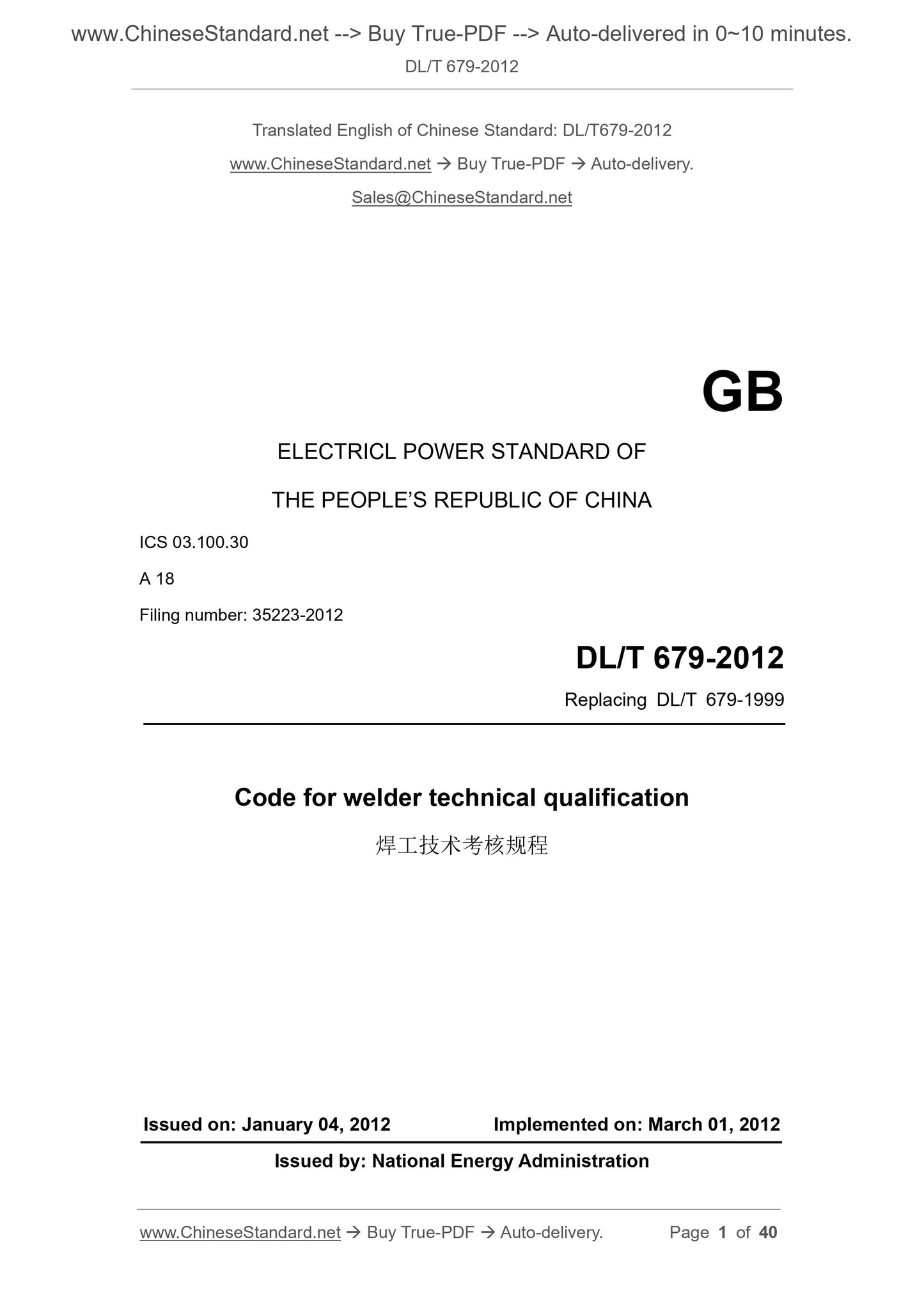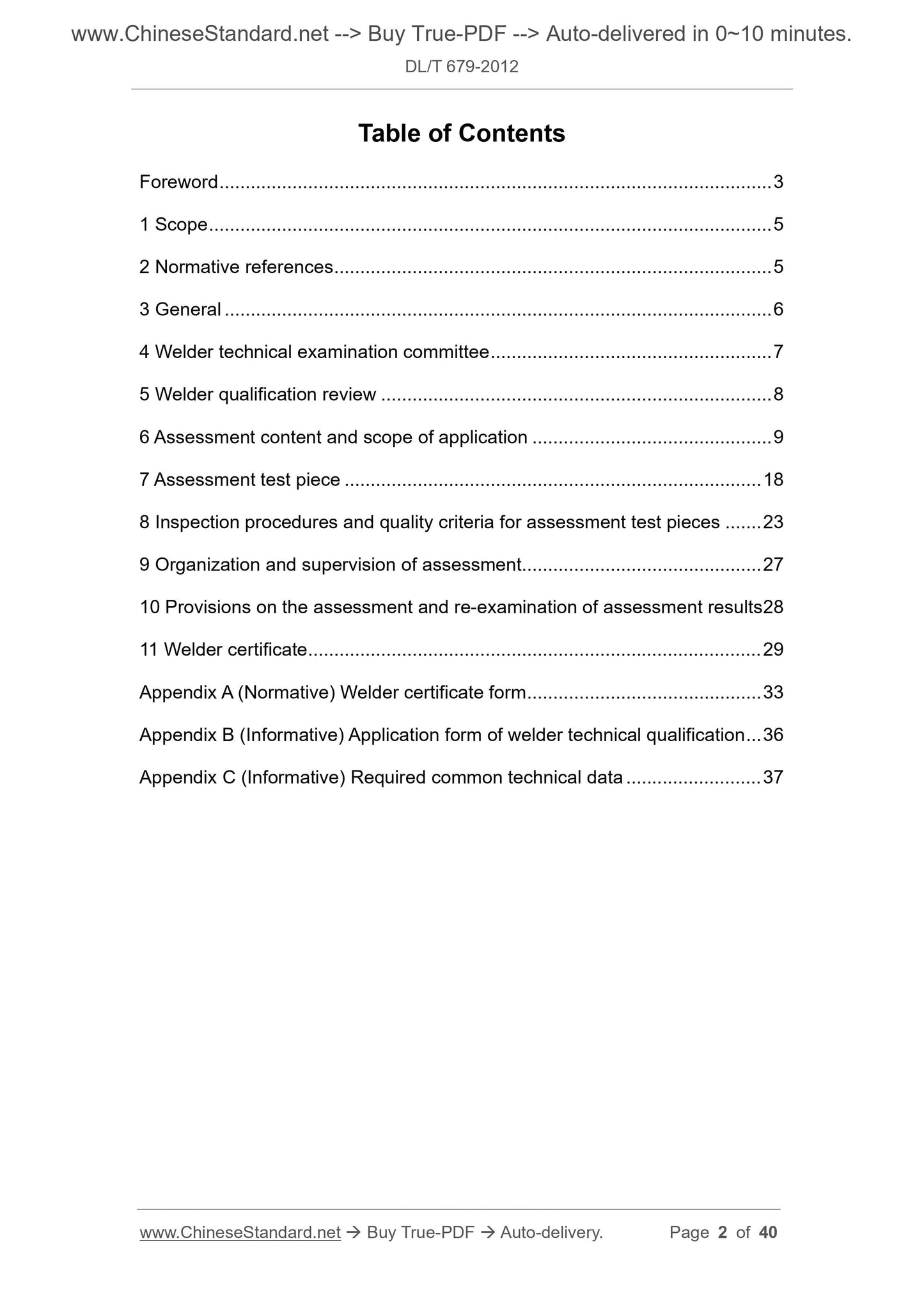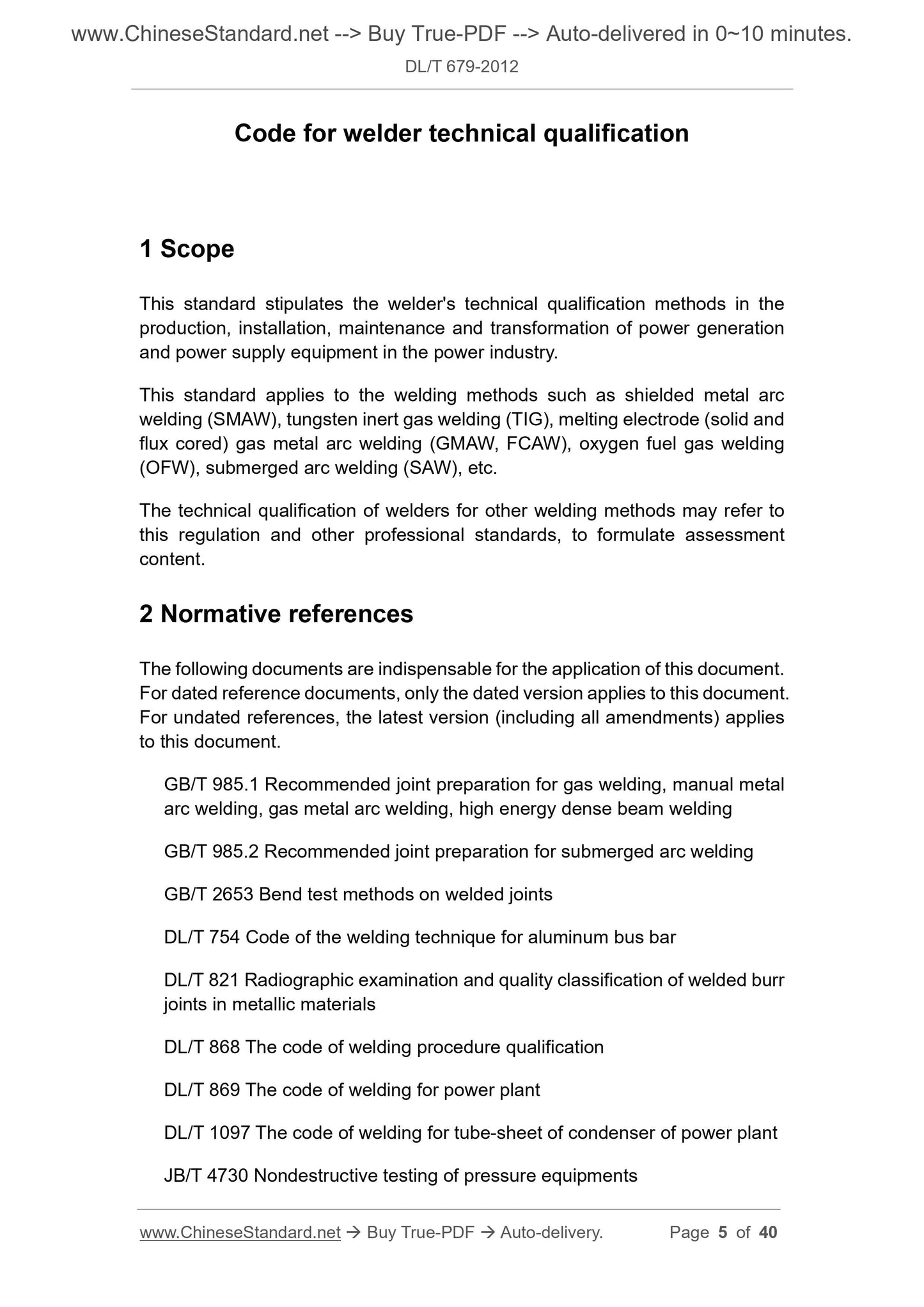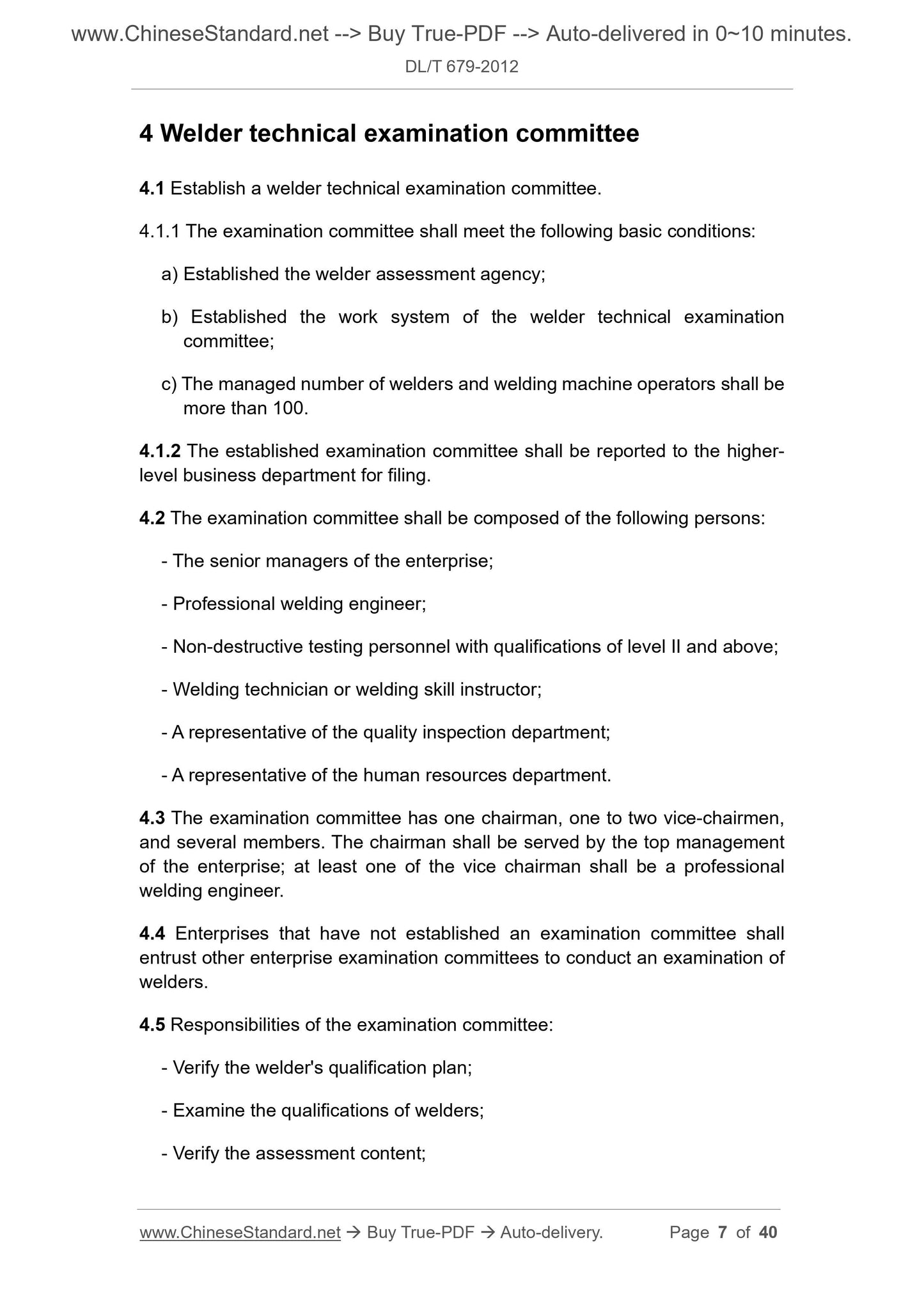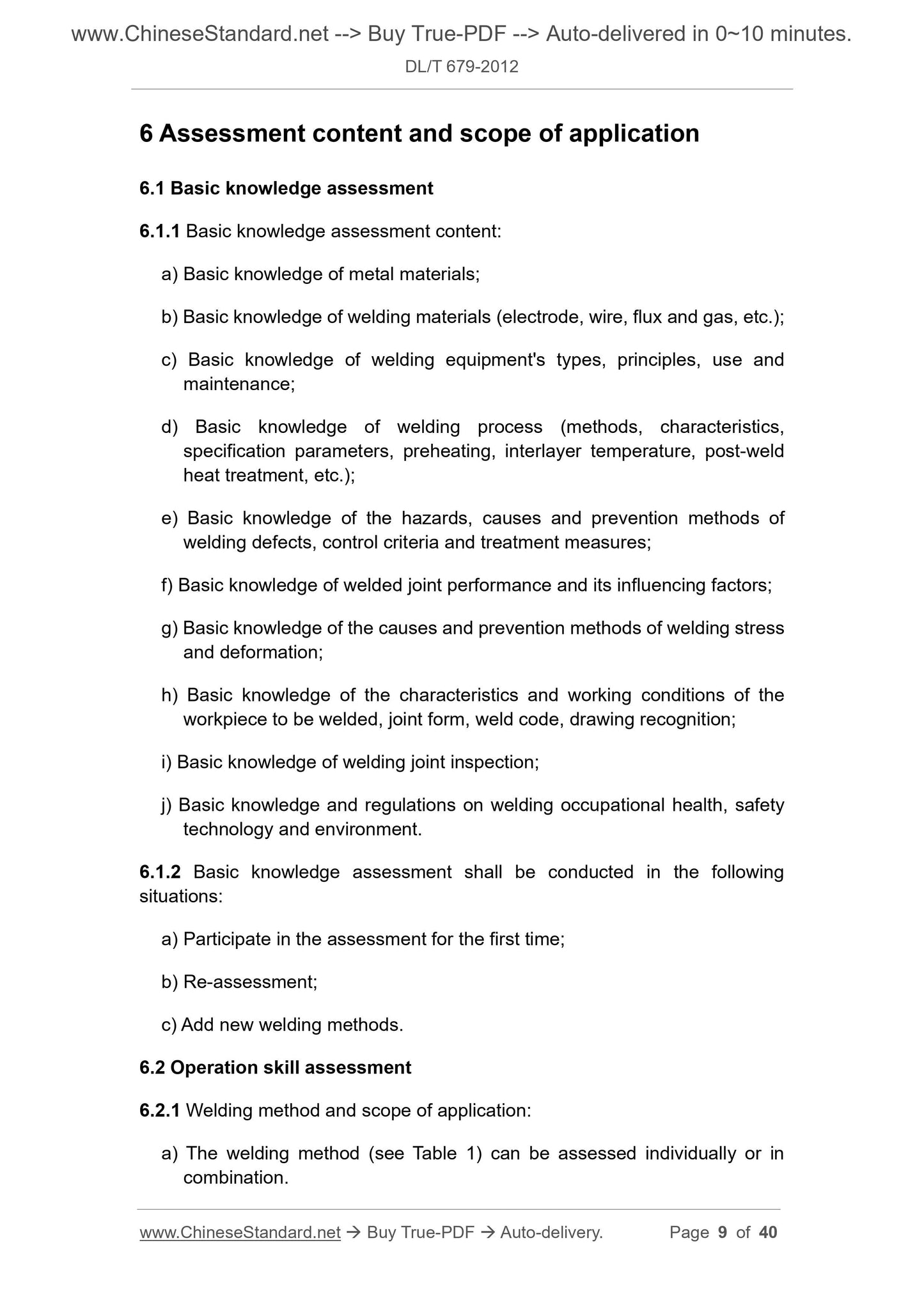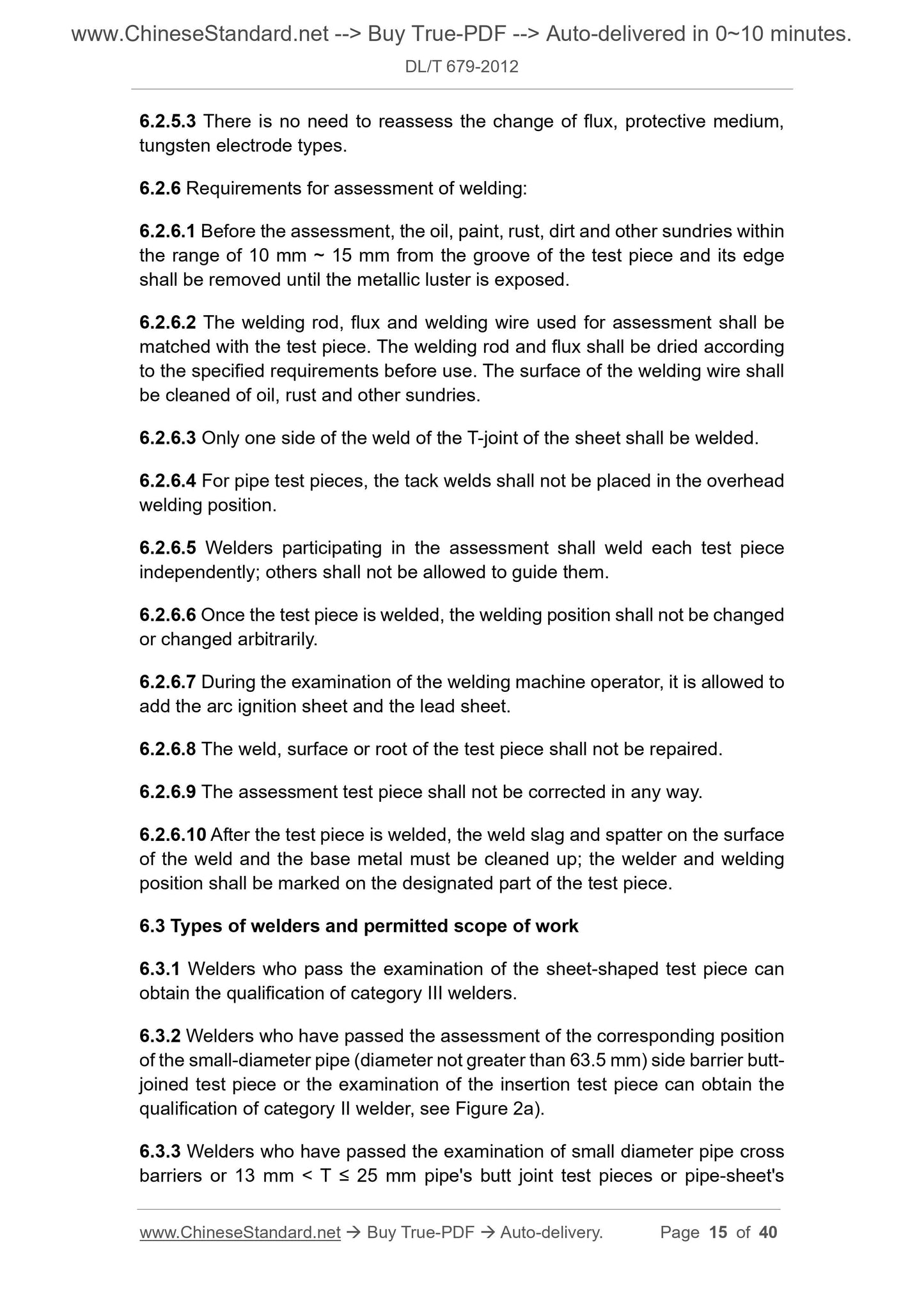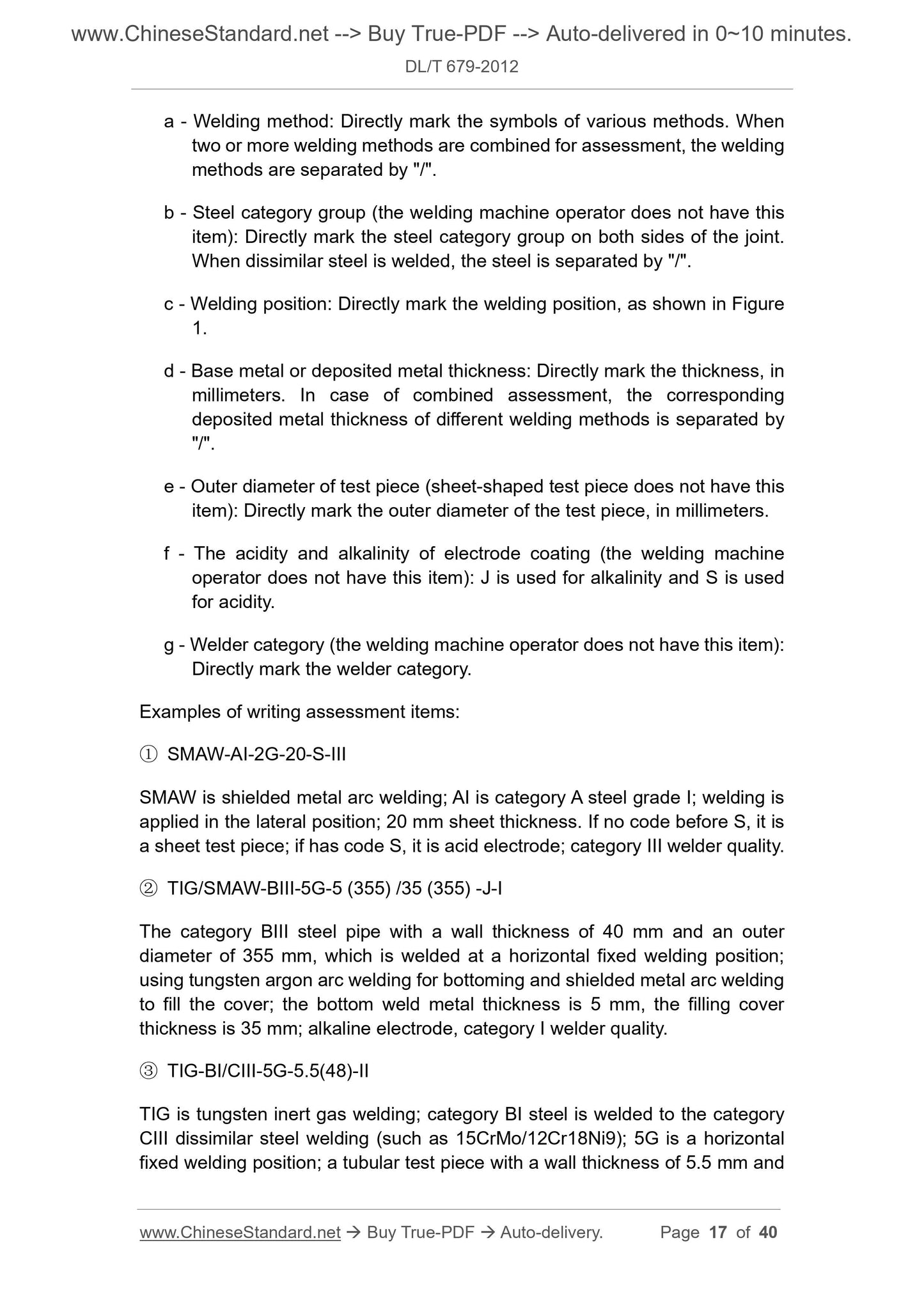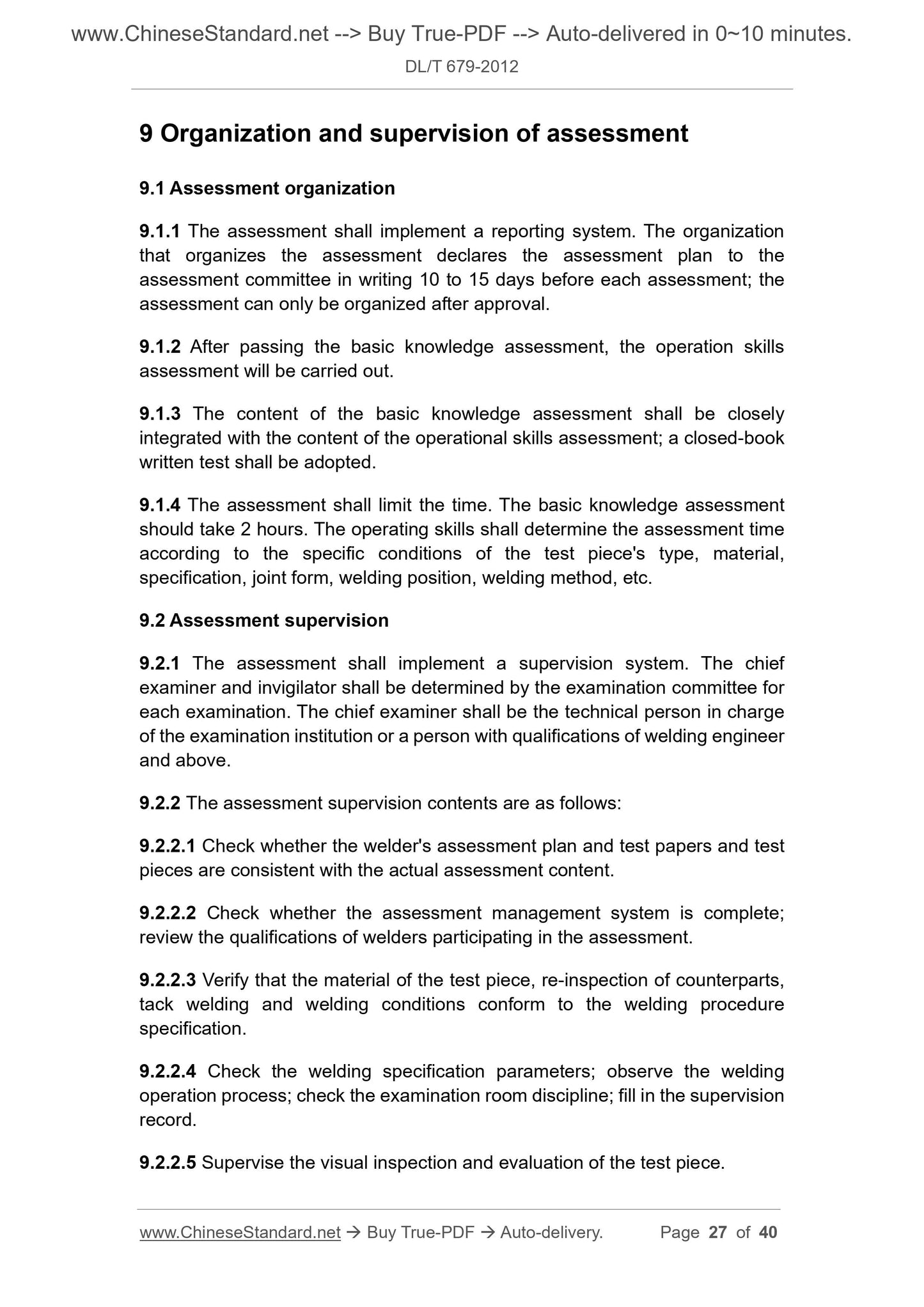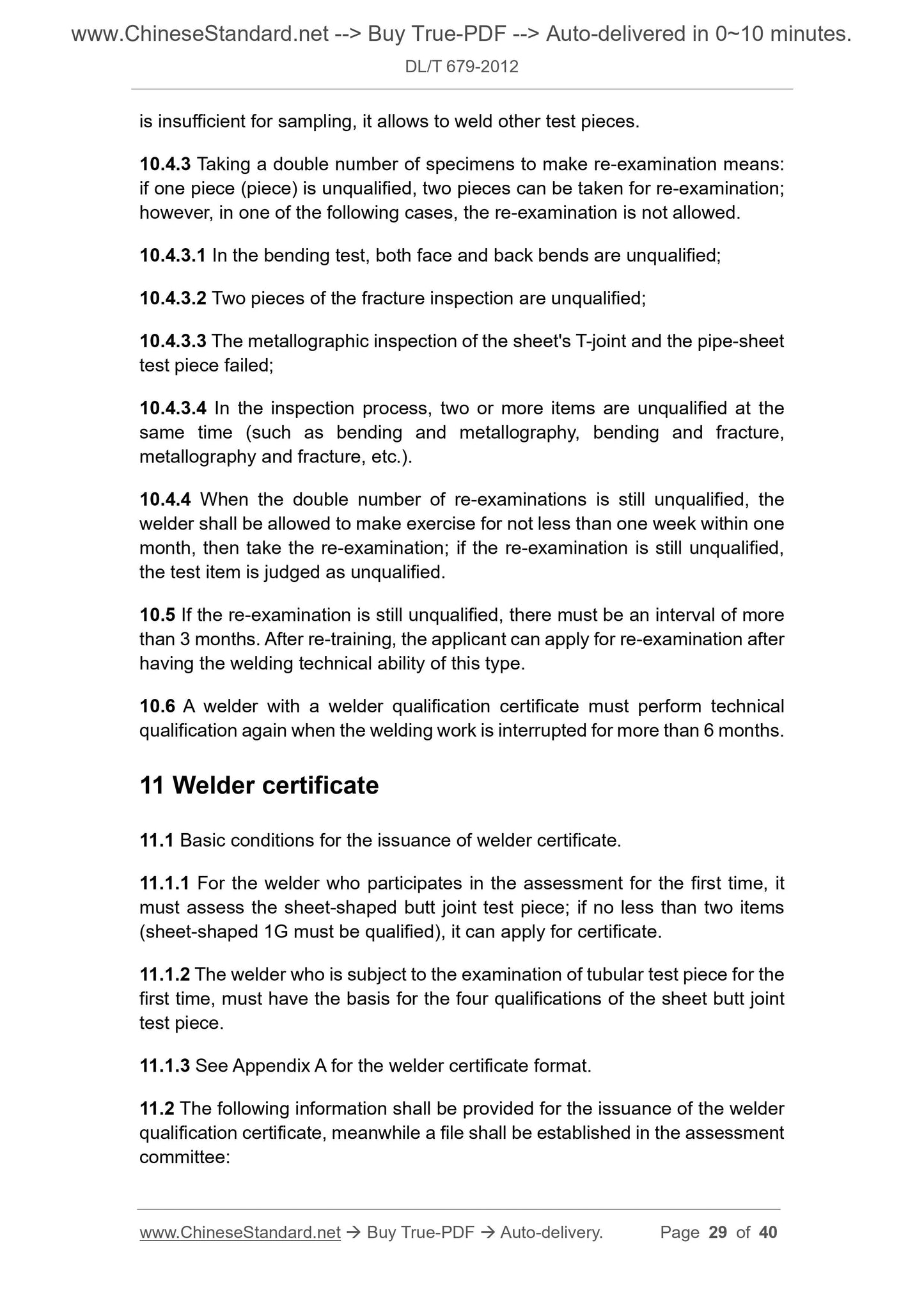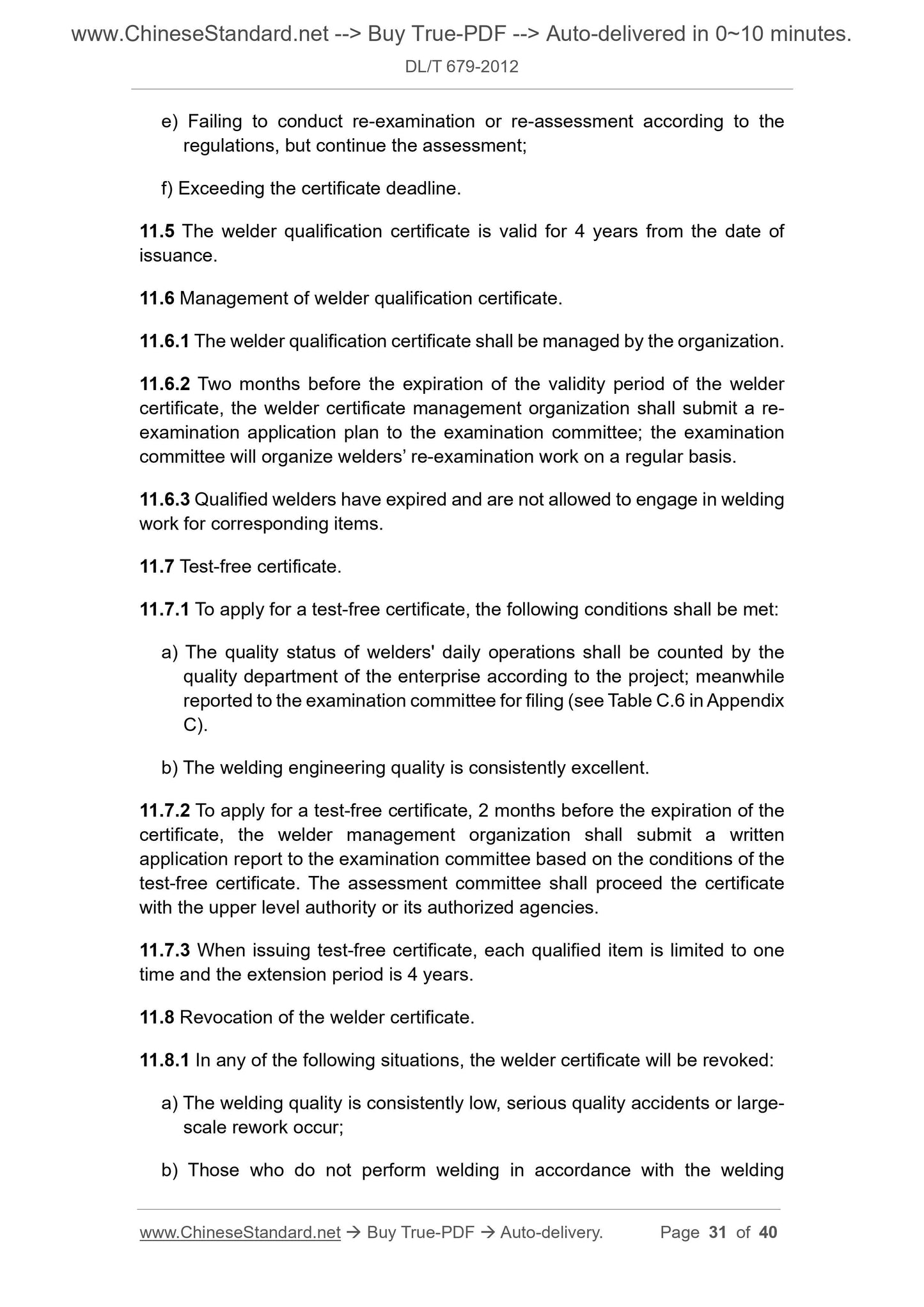1
/
of
10
PayPal, credit cards. Download editable-PDF and invoice in 1 second!
DL/T 679-2012 English PDF (DLT679-2012)
DL/T 679-2012 English PDF (DLT679-2012)
Regular price
$320.00 USD
Regular price
Sale price
$320.00 USD
Unit price
/
per
Shipping calculated at checkout.
Couldn't load pickup availability
Delivery: 3 seconds. Download true-PDF + Invoice.
Get QUOTATION in 1-minute: Click DL/T 679-2012
Historical versions: DL/T 679-2012
Preview True-PDF (Reload/Scroll if blank)
DL/T 679-2012: Code for welder technical qualification
DL/T 679-2012
GB
ELECTRICL POWER STANDARD OF
THE PEOPLE’S REPUBLIC OF CHINA
ICS 03.100.30
A 18
Filing number: 35223-2012
Replacing DL/T 679-1999
Code for welder technical qualification
ISSUED ON: JANUARY 04, 2012
IMPLEMENTED ON: MARCH 01, 2012
Issued by: National Energy Administration
Table of Contents
Foreword ... 3
1 Scope ... 5
2 Normative references ... 5
3 General ... 6
4 Welder technical examination committee ... 7
5 Welder qualification review ... 8
6 Assessment content and scope of application ... 9
7 Assessment test piece ... 18
8 Inspection procedures and quality criteria for assessment test pieces ... 23
9 Organization and supervision of assessment... 27
10 Provisions on the assessment and re-examination of assessment results 28
11 Welder certificate ... 29
Appendix A (Normative) Welder certificate form ... 33
Appendix B (Informative) Application form of welder technical qualification ... 36
Appendix C (Informative) Required common technical data ... 37
Code for welder technical qualification
1 Scope
This standard stipulates the welder's technical qualification methods in the
production, installation, maintenance and transformation of power generation
and power supply equipment in the power industry.
This standard applies to the welding methods such as shielded metal arc
welding (SMAW), tungsten inert gas welding (TIG), melting electrode (solid and
flux cored) gas metal arc welding (GMAW, FCAW), oxygen fuel gas welding
(OFW), submerged arc welding (SAW), etc.
The technical qualification of welders for other welding methods may refer to
this regulation and other professional standards, to formulate assessment
content.
2 Normative references
The following documents are indispensable for the application of this document.
For dated reference documents, only the dated version applies to this document.
For undated references, the latest version (including all amendments) applies
to this document.
GB/T 985.1 Recommended joint preparation for gas welding, manual metal
arc welding, gas metal arc welding, high energy dense beam welding
GB/T 985.2 Recommended joint preparation for submerged arc welding
GB/T 2653 Bend test methods on welded joints
DL/T 754 Code of the welding technique for aluminum bus bar
DL/T 821 Radiographic examination and quality classification of welded burr
joints in metallic materials
DL/T 868 The code of welding procedure qualification
DL/T 869 The code of welding for power plant
DL/T 1097 The code of welding for tube-sheet of condenser of power plant
JB/T 4730 Nondestructive testing of pressure equipments
4 Welder technical examination committee
4.1 Establish a welder technical examination committee.
4.1.1 The examination committee shall meet the following basic conditions:
a) Established the welder assessment agency;
b) Established the work system of the welder technical examination
committee;
c) The managed number of welders and welding machine operators shall be
more than 100.
4.1.2 The established examination committee shall be reported to the higher-
level business department for filing.
4.2 The examination committee shall be composed of the following persons:
- The senior managers of the enterprise;
- Professional welding engineer;
- Non-destructive testing personnel with qualifications of level II and above;
- Welding technician or welding skill instructor;
- A representative of the quality inspection department;
- A representative of the human resources department.
4.3 The examination committee has one chairman, one to two vice-chairmen,
and several members. The chairman shall be served by the top management
of the enterprise; at least one of the vice chairman shall be a professional
welding engineer.
4.4 Enterprises that have not established an examination committee shall
entrust other enterprise examination committees to conduct an examination of
welders.
4.5 Responsibilities of the examination committee:
- Verify the welder's qualification plan;
- Examine the qualifications of welders;
- Verify the assessment content;
6 Assessment content and scope of application
6.1 Basic knowledge assessment
6.1.1 Basic knowledge assessment content:
a) Basic knowledge of metal materials;
b) Basic knowledge of welding materials (electrode, wire, flux and gas, etc.);
c) Basic knowledge of welding equipment's types, principles, use and
maintenance;
d) Basic knowledge of welding process (methods, characteristics,
specification parameters, preheating, interlayer temperature, post-weld
heat treatment, etc.);
e) Basic knowledge of the hazards, causes and prevention methods of
welding defects, control criteria and treatment measures;
f) Basic knowledge of welded joint performance and its influencing factors;
g) Basic knowledge of the causes and prevention methods of welding stress
and deformation;
h) Basic knowledge of the characteristics and working conditions of the
workpiece to be welded, joint form, weld code, drawing recognition;
i) Basic knowledge of welding joint inspection;
j) Basic knowledge and regulations on welding occupational health, safety
technology and environment.
6.1.2 Basic knowledge assessment shall be conducted in the following
situations:
a) Participate in the assessment for the first time;
b) Re-assessment;
c) Add new welding methods.
6.2 Operation skill assessment
6.2.1 Welding method and scope of application:
a) The welding method (see Table 1) can be assessed individually or in
combination.
6.2.5.3 There is no need to reassess the change of flux, protective medium,
tungsten electrode types.
6.2.6 Requirements for assessment of welding:
6.2.6.1 Before the assessment, the oil, paint, rust, dirt and other sundries within
the range of 10 mm ~ 15 mm from the groove of the test piece and its edge
shall be removed until the metallic luster is exposed.
6.2.6.2 The welding rod, flux and welding wire used for assessment shall be
matched with the test piece. The welding rod and flux shall be dried according
to the specified requirements before use. The surface of the welding wire shall
be cleaned of oil, rust and other sundries.
6.2.6.3 Only one side of the weld of the T-joint of the sheet shall be welded.
6.2.6.4 For pipe test pieces, the tack welds shall not be placed in the overhead
welding position.
6.2.6.5 Welders participating in the assessment shall weld each test piece
independently; others shall not be allowed to guide them.
6.2.6.6 Once the test piece is welded, the welding position shall not be changed
or changed arbitrarily.
6.2.6.7 During the examination of the welding machine operator, it is allowed to
add the arc ignition sheet and the lead sheet.
6.2.6.8 The weld, surface or root of the test piece shall not be repaired.
6.2.6.9 The assessment test piece shall not be corrected in any way.
6.2.6.10 After the test piece is welded, the weld slag and spatter on the surface
of the weld and the base metal must be cleaned up; the welder and welding
position shall be marked on the designated part of the test piece.
6.3 Types of welders and permitted scope of work
6.3.1 Welders who pass the examination of the sheet-shaped test piece can
obtain the qualification of category III welders.
6.3.2 Welders who have passed the assessment of the corresponding position
of the small-diameter pipe (diameter not greater...
Get QUOTATION in 1-minute: Click DL/T 679-2012
Historical versions: DL/T 679-2012
Preview True-PDF (Reload/Scroll if blank)
DL/T 679-2012: Code for welder technical qualification
DL/T 679-2012
GB
ELECTRICL POWER STANDARD OF
THE PEOPLE’S REPUBLIC OF CHINA
ICS 03.100.30
A 18
Filing number: 35223-2012
Replacing DL/T 679-1999
Code for welder technical qualification
ISSUED ON: JANUARY 04, 2012
IMPLEMENTED ON: MARCH 01, 2012
Issued by: National Energy Administration
Table of Contents
Foreword ... 3
1 Scope ... 5
2 Normative references ... 5
3 General ... 6
4 Welder technical examination committee ... 7
5 Welder qualification review ... 8
6 Assessment content and scope of application ... 9
7 Assessment test piece ... 18
8 Inspection procedures and quality criteria for assessment test pieces ... 23
9 Organization and supervision of assessment... 27
10 Provisions on the assessment and re-examination of assessment results 28
11 Welder certificate ... 29
Appendix A (Normative) Welder certificate form ... 33
Appendix B (Informative) Application form of welder technical qualification ... 36
Appendix C (Informative) Required common technical data ... 37
Code for welder technical qualification
1 Scope
This standard stipulates the welder's technical qualification methods in the
production, installation, maintenance and transformation of power generation
and power supply equipment in the power industry.
This standard applies to the welding methods such as shielded metal arc
welding (SMAW), tungsten inert gas welding (TIG), melting electrode (solid and
flux cored) gas metal arc welding (GMAW, FCAW), oxygen fuel gas welding
(OFW), submerged arc welding (SAW), etc.
The technical qualification of welders for other welding methods may refer to
this regulation and other professional standards, to formulate assessment
content.
2 Normative references
The following documents are indispensable for the application of this document.
For dated reference documents, only the dated version applies to this document.
For undated references, the latest version (including all amendments) applies
to this document.
GB/T 985.1 Recommended joint preparation for gas welding, manual metal
arc welding, gas metal arc welding, high energy dense beam welding
GB/T 985.2 Recommended joint preparation for submerged arc welding
GB/T 2653 Bend test methods on welded joints
DL/T 754 Code of the welding technique for aluminum bus bar
DL/T 821 Radiographic examination and quality classification of welded burr
joints in metallic materials
DL/T 868 The code of welding procedure qualification
DL/T 869 The code of welding for power plant
DL/T 1097 The code of welding for tube-sheet of condenser of power plant
JB/T 4730 Nondestructive testing of pressure equipments
4 Welder technical examination committee
4.1 Establish a welder technical examination committee.
4.1.1 The examination committee shall meet the following basic conditions:
a) Established the welder assessment agency;
b) Established the work system of the welder technical examination
committee;
c) The managed number of welders and welding machine operators shall be
more than 100.
4.1.2 The established examination committee shall be reported to the higher-
level business department for filing.
4.2 The examination committee shall be composed of the following persons:
- The senior managers of the enterprise;
- Professional welding engineer;
- Non-destructive testing personnel with qualifications of level II and above;
- Welding technician or welding skill instructor;
- A representative of the quality inspection department;
- A representative of the human resources department.
4.3 The examination committee has one chairman, one to two vice-chairmen,
and several members. The chairman shall be served by the top management
of the enterprise; at least one of the vice chairman shall be a professional
welding engineer.
4.4 Enterprises that have not established an examination committee shall
entrust other enterprise examination committees to conduct an examination of
welders.
4.5 Responsibilities of the examination committee:
- Verify the welder's qualification plan;
- Examine the qualifications of welders;
- Verify the assessment content;
6 Assessment content and scope of application
6.1 Basic knowledge assessment
6.1.1 Basic knowledge assessment content:
a) Basic knowledge of metal materials;
b) Basic knowledge of welding materials (electrode, wire, flux and gas, etc.);
c) Basic knowledge of welding equipment's types, principles, use and
maintenance;
d) Basic knowledge of welding process (methods, characteristics,
specification parameters, preheating, interlayer temperature, post-weld
heat treatment, etc.);
e) Basic knowledge of the hazards, causes and prevention methods of
welding defects, control criteria and treatment measures;
f) Basic knowledge of welded joint performance and its influencing factors;
g) Basic knowledge of the causes and prevention methods of welding stress
and deformation;
h) Basic knowledge of the characteristics and working conditions of the
workpiece to be welded, joint form, weld code, drawing recognition;
i) Basic knowledge of welding joint inspection;
j) Basic knowledge and regulations on welding occupational health, safety
technology and environment.
6.1.2 Basic knowledge assessment shall be conducted in the following
situations:
a) Participate in the assessment for the first time;
b) Re-assessment;
c) Add new welding methods.
6.2 Operation skill assessment
6.2.1 Welding method and scope of application:
a) The welding method (see Table 1) can be assessed individually or in
combination.
6.2.5.3 There is no need to reassess the change of flux, protective medium,
tungsten electrode types.
6.2.6 Requirements for assessment of welding:
6.2.6.1 Before the assessment, the oil, paint, rust, dirt and other sundries within
the range of 10 mm ~ 15 mm from the groove of the test piece and its edge
shall be removed until the metallic luster is exposed.
6.2.6.2 The welding rod, flux and welding wire used for assessment shall be
matched with the test piece. The welding rod and flux shall be dried according
to the specified requirements before use. The surface of the welding wire shall
be cleaned of oil, rust and other sundries.
6.2.6.3 Only one side of the weld of the T-joint of the sheet shall be welded.
6.2.6.4 For pipe test pieces, the tack welds shall not be placed in the overhead
welding position.
6.2.6.5 Welders participating in the assessment shall weld each test piece
independently; others shall not be allowed to guide them.
6.2.6.6 Once the test piece is welded, the welding position shall not be changed
or changed arbitrarily.
6.2.6.7 During the examination of the welding machine operator, it is allowed to
add the arc ignition sheet and the lead sheet.
6.2.6.8 The weld, surface or root of the test piece shall not be repaired.
6.2.6.9 The assessment test piece shall not be corrected in any way.
6.2.6.10 After the test piece is welded, the weld slag and spatter on the surface
of the weld and the base metal must be cleaned up; the welder and welding
position shall be marked on the designated part of the test piece.
6.3 Types of welders and permitted scope of work
6.3.1 Welders who pass the examination of the sheet-shaped test piece can
obtain the qualification of category III welders.
6.3.2 Welders who have passed the assessment of the corresponding position
of the small-diameter pipe (diameter not greater...
Share
